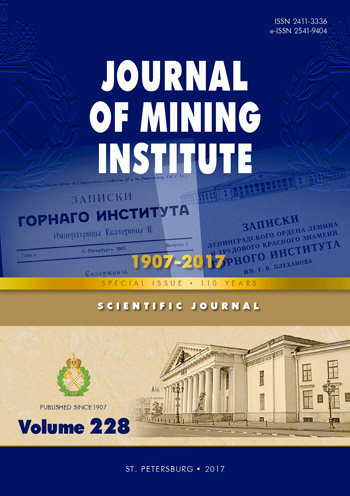Influence of dispersing additives and blend composition on stability of marine high-viscosity fuels
- 1 — Ph.D., Dr.Sci. Head of department All-Russian Scientific Research Institute for Oil Refining
- 2 — Ph.D., Dr.Sci. Professor, Head of department Saint-Petersburg Mining University
- 3 — Ph.D. Head of Laboratory All-Russian Scientific Research Institute for Oil Refining
- 4 — Ph.D. Head of department All-Russian Scientific Research Institute for Oil Refining
- 5 — post-graduate student Saint-Petersburg Mining University
Abstract
The article offers a definition of the stability of marine high-viscosity fuel from the point of view of the colloid-chemical concept of oil dispersed systems. The necessity and importance of the inclusion in the current regulatory requirements of this quality parameter of high-viscosity marine fuel is indicated. The objects of the research are high-viscosity marine fuels, the basic components of which are heavy oil residues: fuel oil that is the atmospheric residue of oil refining and viscosity breaking residue that is the product of light thermal cracking of fuel oil. As a thinning agent or distillate component, a light gas oil was taken from the catalytic cracking unit. The stability of the obtained samples was determined through the xylene equivalent index, which characterizes the stability of marine high-viscosity fuel to lamination during storage, transportation and operation processes. To improve performance, the resulting base compositions of high-viscosity marine fuels were modified by introducing small concentrations (0.05 % by weight) of stabilizing additives based on oxyethylated amines of domestic origin and alkyl naphthalenes of foreign origin.
Funding
The applied scientific research has been carried out with the financial support of the Ministry of Education and Science of the Russian Federation within the framework of the federal target program «Research and Development in Priority Areas for the Development of the Scientific and Technical Complex of Russia for 2014-2020» in accordance with Agreement No. 14.576.21.0088 on granting a subsidy on «Development of technology for direct and indirect hydrotreating of black oil to obtain the marine fuel with improved environmental characteristics»(unique identifier of works RFMEFI57617X0088)
References
- Al'farG., ElversB. Fuels. Production, application and properties. Per. s angl. Ed. by. T.N.Mitusovoi. St.Petersburg: Professiya, 2012, p. 413 (in Russian).
- Castañeda L.C. Combined process schemes for upgrading of heavy petroleum / L.C.Castañeda, J.A.D.Muñoz, J.Ancheyta // Fuel. 2012. Vol. 100. P. 110-127. DOI: 10.1016/j.fuel.2012.02.022.
- Gawrys K.L. The role of asphaltene solubility and chemical composition on asphaltene aggregation / K.L.Gawrys, P. Matthew Spiecker, P.K. Kilpatrick // Petroleum science and technology. 2003. Vol.21. № 3-4. P. 461-489. DOI: 10.1081/LFT-120018533.
- Effect of Hydrocarbon Composition on Quality and Operating Characteristics of Middle Distillate Fractions and Low-Viscosity Marine Fuels / N.K.Kondrasheva, D.O.Kondrashev, V.A.Rudko, A.A.Shaidulina // Chemistry and Technology of Fuels and Oils. 2017. Vol. 53. P. 163-172. DOI: 10.1007/s10553-017-0792-8.
- Kondrasheva N.K. Modern hydroprocesses for the synthesis of high-quality low-viscous marine fuels / N.K.Kondrasheva, D.O.Kondrashev // Catalysis in Industry. 2017. Vol. 9. №. 1. P. 1-9. DOI: 10.1134/S207005041701007X.
- Laux H. Theoretical and practical approach to the selection of asphaltene dispersing agents / H.Laux, I.Rahimian, T.Butz // Fuel Processing Technology. 2000. Vol. 67. № 1. P. 79-89. DOI: 10.1016/S0378-3820(00)00087-4.
- Murzakov R.M. Influence of petroleum resins on colloidal stability of asphaltene-containing disperse systems / R.M.Murzakov, S.A.Sabanenkov, Z.I.Syunyaev // Chemistry and Technology of Fuels and Oils. 1980. Vol.16. N. 10. P. 674-677. DOI: 10.1007/BF00726261.
- Nikooyeh K. Interactions between Athabasca pentane asphaltenes and n-alkanes at low concentrations / K.Nikooyeh, S.R.Bagheri, J.M.Shaw // Energy & Fuels. 2012. Vol. 26. № 3. P. 1756-1766. DOI: 10.1021/ef201845a.
- Patent № 8987537 US. Fuel compositions / D.F.Droubi, M.A.Branch, C.Delaney-Kinsella, D.T.Lipinsky, L.S.Kraus T.L.Brumfield, A.Bru, K.Steernberg, P.Tardif, S.Boudreaux. Opubl. 24.03.2015.
- Patent № 14/943313 US. Low sulfur marine bunker fuels and methods of making same / C.E.Robinson, S.Dawe, E.Karlsson , H.Grati. Opubl. 09.06.2015.
- Patent № 14/932379 US. Process for the production of fuels of heavy fuel type from a heavy hydrocarbon-containing feedstock using a separation between the hydrotreatment stage and the hydrocracking stage / W.Weiss, I.Merdrignac. Opubl. 25.06.2015.
- Particle size distributions from heavy-duty diesel engine operated on low-sulfur marine fuel / S.Ushakov, H.Valland, J.B.Nielsen, E.Hennie // Fuel processing technology. 2013. Vol. 106. P. 350-358. DOI: 10.1016/j.fuproc.2012.08.022.
- Zamiatina N. Comparative overview of marine fuel quality on diesel engine operation // Procedia Engineering. 2016. Vol. 134. P. 157-164. DOI: 10.1016/j.proeng.2016.01.055.
